Compare
Best price guarantee
Tire replacement coverage
24/7 roadside assistance
Easy returns
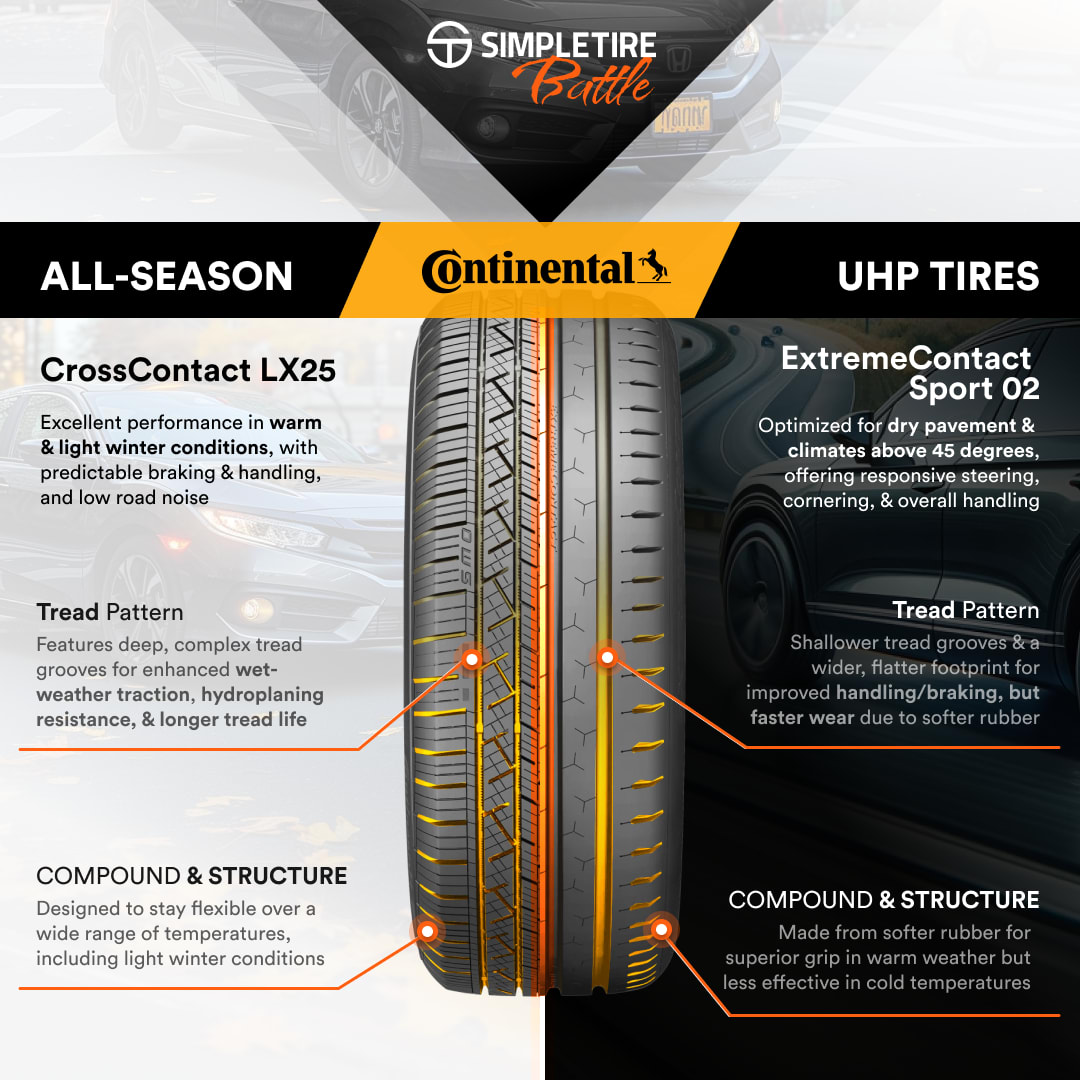
Let’s just start by noting that for many drivers, tires are something they don’t give a lot of thought to until one fails or it’s time to replace them. For most drivers, tires are round black, hold air, get you where you want to go, and back again, and that’s about where their engagement with tires ends. For most drivers of sedans, coupes, minivans, SUVs, and crossovers, all-season tires are the tire option that makes the most sense. A premium set of all-season tires will deliver long wear with a generous limited manufacturer’s tread life warranty, a ride that’s quiet and comfortable, handling that’s competent and predictable, and road manners that are stable and secure.
And like you’d expect, all-season tires are designed to offer versatile traction to be used year-round (or close to it). But then, when it comes to performance cars, as capable as all-season tires are in most aspects, they often fall a little short of the kind of steering response, cornering ability, braking performance, and overall driving dynamics that can allow a driver to get the most out of their car’s handling potential. For high-speed performance and the ability to handle the torque, horsepower, handling ability, and overall expectations of drivers who like to push the limits, ultra-high-performance (UHP) summer tires are the only thing for it.
The difference between ultra-high-performance and all-season tires
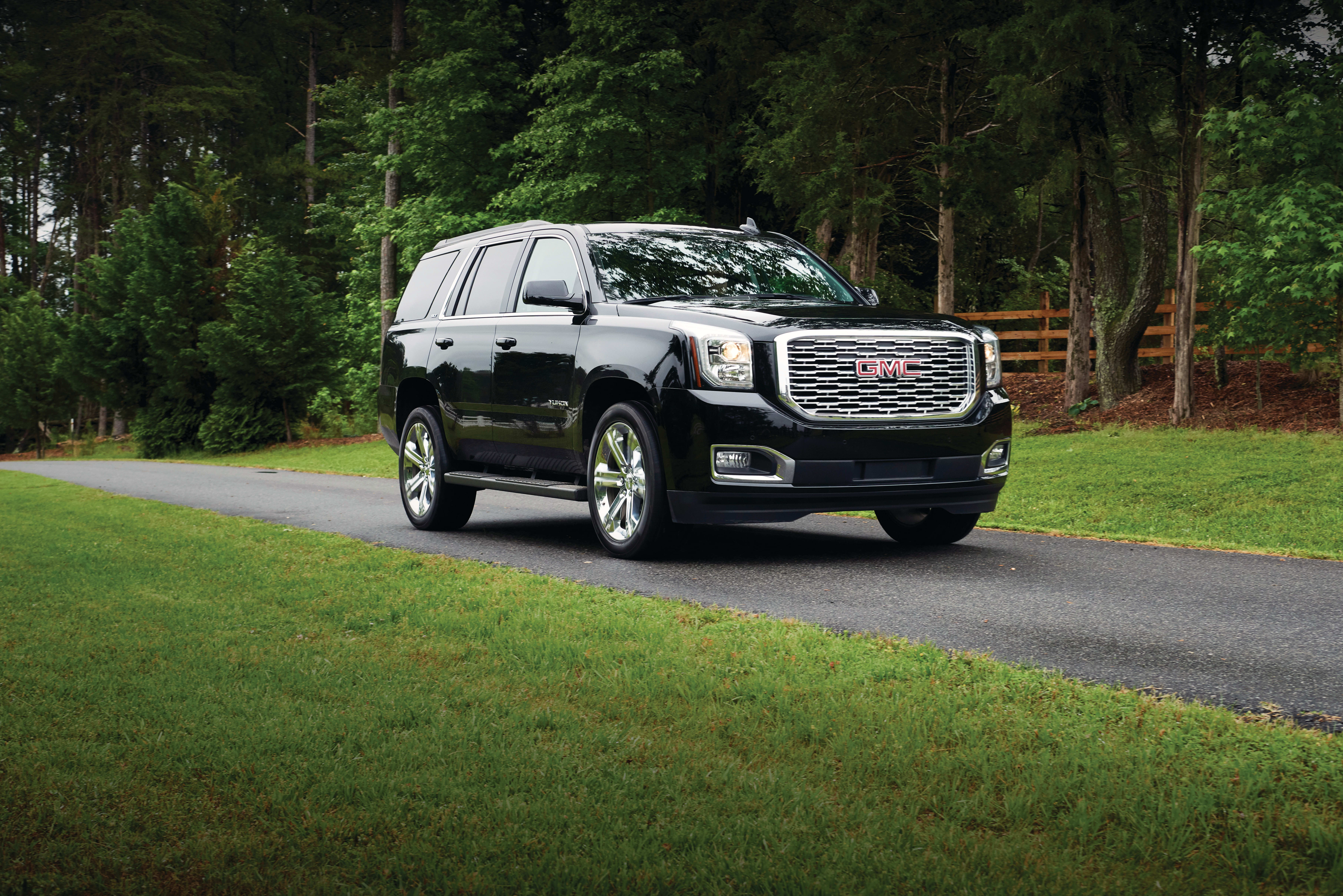
UHP tires are designed for a real, tangible advantage in handling, braking, steering response, and high-speed capability over all-season tires; that’s why they’re featured as original equipment (OEM) on high-end sports sedans, sports cars, and sporty coupes and crossovers. That means they have some key differences compared to all-season tires. As a vehicle starts negotiating a turn or a corner, the forward momentum of the car tries to keep directing the vehicle forward. The tires must get enough traction to arrest that forward momentum and change the vehicle’s direction. Still, the weight and inertia of the car will cause the tire to distort, and the inboard side of the tire can even start to leave the pavement altogether. That distortion is called “tread squirm” and the tire’s shoulders and tread area need to be rigid enough to resist that tendency, so UHP tires have a shoulder and tread area that are reinforced for extra stiffness.
Another key difference between UHP and all-season tires is the tread compound. All-season tires need to adhere to the pavement like glue and use a tread formulation that’s softer and “stickier”. In some cases, it’s soft enough that pressing a thumbnail into the sidewall can leave a little indentation that takes a moment to spring back again. Think about a piece of rubber that’s as soft as a kid’s pencil eraser, and that’s about how soft some UHP tires are. Of course, that also means shorter tread life, which is why many UHP tires don’t come with a limited manufacturer’s tread life warranty. Also, any rubber compound that is that soft will stiffen up and lose grip in colder weather – in the tire industry, the threshold of 40-45 degrees F is known informally as the “glass transition temperature” where UHP or summer tires will harden and begin to lose traction. That’s why tire manufacturers advise against using UHP tires when daily temperatures are below that level; UHP tires can lose enough traction and performance ability to be unsafe on colder days. Think about a flexible rubber boot on cold, slick pavement versus a hard rubber hockey puck, and that’s a pretty good illustration.
All-season tires don’t have that problem at lower temperatures; they’re designed with a rubber compound that should stay flexible year-round and for better wear properties. Most all-season tires also feature a tread pattern more suited to year-round driving conditions, with circumferential and angled grooves that evacuate standing water from the tire’s contact patch to resist hydroplaning on wet roads. They also commonly have a dense network of sipes, the tiny, angled hair-thin slits that multiply the tread’s surface area and traction by providing hundreds of extra edges that handily slice through standing water, snow, or slush on winter days.
As for handling and ride quality, that can vary a lot from one all-season tire to another. Many tires are marketed as UHP all-season tires, and many of those do provide handling and performance that’s sharper and more nimble than other all-season tires. Still, the catch is that no industry standard or government rating system defines what a UHP all-season tire should be and how it should perform. In terms of ride quality and road manners, all-season tires are more consistent, with a tread pitch that’s computer-tuned to help cancel certain frequencies and resonances and kill road noise. Some premium all-season tires even incorporate a foam layer in their ply package that can soak up vibrations and roughness and deaden road noise – a feature you won’t find on many UHP tires, if ever. In other words, you can think of all-season tires as a Swiss Army Knife of the tire world – versatile, but maybe not the best at each function. Or, maybe more like a 3-in-1 body wash/shampoo/conditioner: not the best body wash, shampoo, or conditioner you've ever tried, but pretty convenient and gets the job done from one day to the next.
Ultra-High-Performance vs all-season tires fuel economy
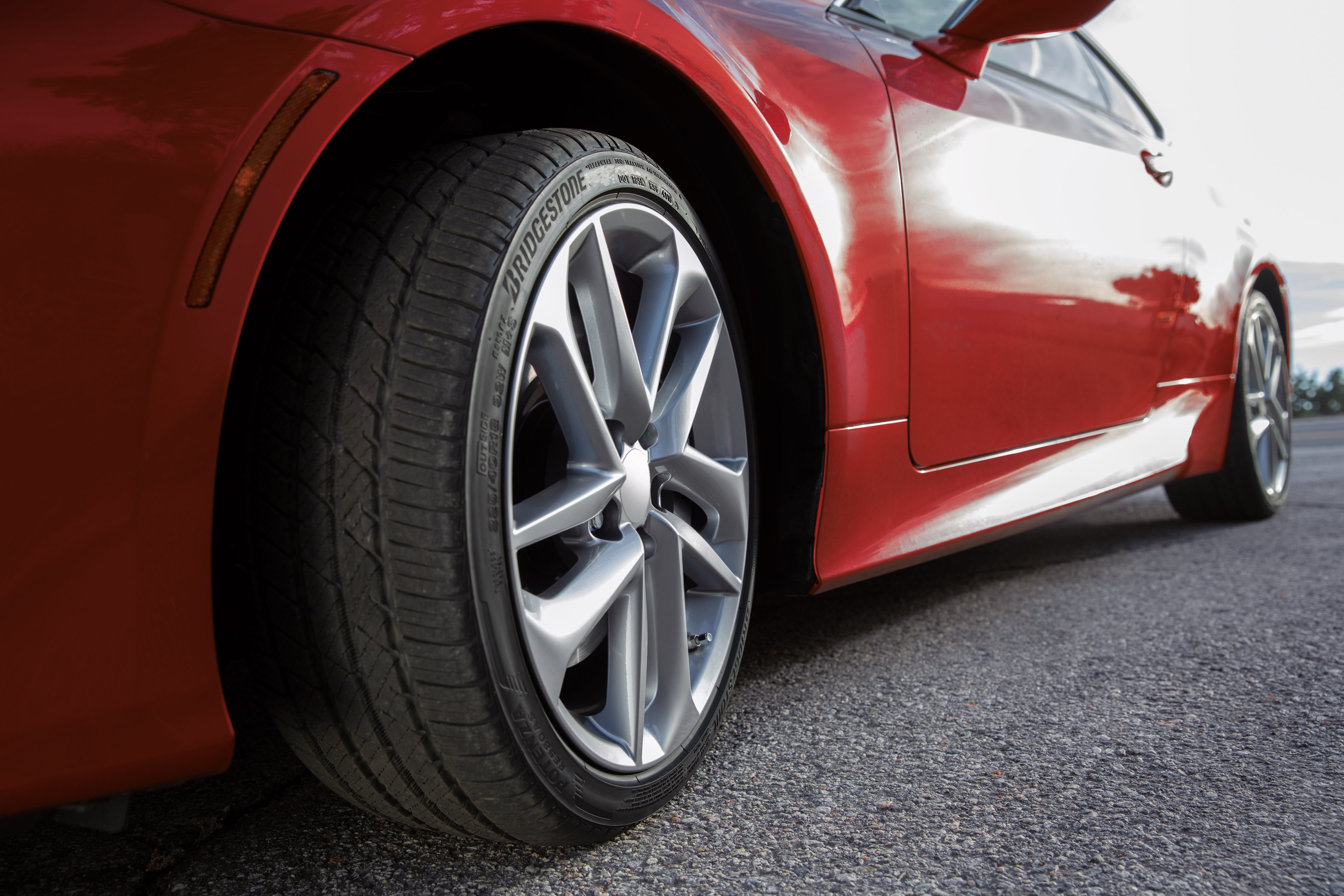
When it comes to fuel economy for UHP and all-season tires, results can vary greatly. In the last twenty years or so, cutting down on rolling resistance (the friction that goes along with getting a vehicle going and headed down the road) has become a priority for many tire manufacturers because lower rolling resistance means less work for the engine and drivetrain, improved fuel economy, and lower hydrocarbon emissions.
As a general rule in the past, the more aggressive a tire’s tread pattern was, the more rolling resistance you could expect. That’s not a hard-and-fast rule, though – by that logic, a tire worn out with less than 2/32” of tread depth would get superior fuel economy and lower rolling resistance. Today, though, rolling resistance is a function of all kinds of things: the tread formulation, the tire’s internal construction, the tire’s tread pattern, its weight, and so on. UHP and summer tires use a simpler tread design, often without the sipes, angled grooves, and other features found on all-season tires, so it would seem that they’d do better in rolling resistance. But then again, that stickier tread formulation seems like it would create more drag and friction while rolling down the highway, so which is it?
For today’s vehicles and tires, rolling resistance and fuel economy outcomes can vary from one tire to the next and one tire manufacturer to the next. That’s true whether they’re UHP, all-season, winter, or light truck tires, and it all depends on whether rolling resistance was one of the design targets that the tire manufacturer’s engineering team was aiming for.
Ultra-High-Performance vs all-season tires in rain
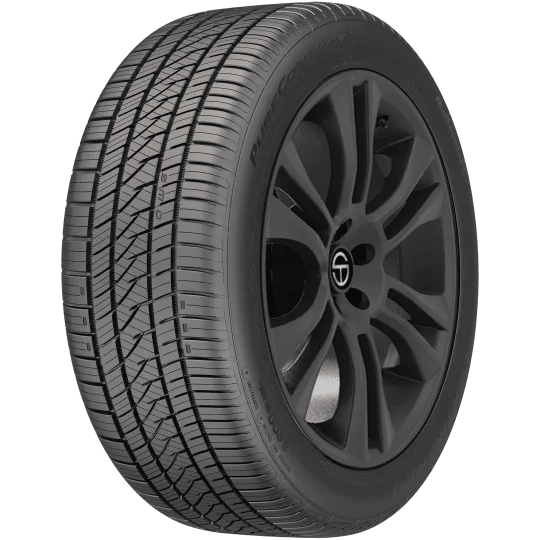
We already know that all-season tires are designed for year-round traction, including dry weather, wet weather, and light winter conditions. They’re designed with circumferential grooves, angled grooves, and sipes (as we discussed). Many use a silica-enriched tread formulation that helps boost wet-weather performance and enhance the tire’s wear properties. But what about UHP tires and rainy weather?
Remember that the top tire manufacturers (think Pirelli, Continental, Bridgestone, Goodyear, Yokohama, etc.) all have decades of experience in the motorsports arena, meaning everything from autocross and rallies to Formula One, NASCAR, and Le Mans. Those tires also inform all aspects of how their UHP tires are designed, including tread patterns, internal design, shoulder design, rubber formulation, and much more. Do cars that run in 24 Hours of LeMans only run in dry weather? Of course, they don’t. UHP tires might not have as complex a tread pattern as all-season or Grand Touring tires, but they have many of the same features designed to cut through standing water or route it through and behind the tire’s contact patch to resist hydroplaning on wet roads. Again, this can change from one tire and manufacturer to another, but most UHP tires are designed to perform capably in the rain.
Ultra-High-Performance vs all-season tires tread life
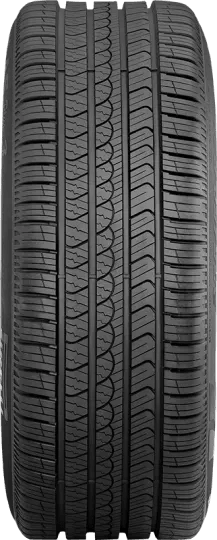
There’s a big difference between what you can expect from all-season tire tread life and UHP tire tread life. All-season tires are designed with tread life as a priority. That entails the tread pattern (often with a deeper initial tread depth to its grooves), the rubber formulation, the internal design, and shoulder design, and the result is all-season tires that are sometimes covered by as much as a 90,000 mile limited manufacturer tread life warranty (the kind of warranty coverage that was unheard of a generation ago). Things have come so far that many tier-2 all-season and Grand Touring tires have over 50,000 miles of warranty coverage.
On the other hand, UHP tires seldom come with a mileage warranty. That comes back to their connection to motorsports – tires on Formula One or Le Mans, or NASCAR cars aren’t made for long miles or tread life. They’re designed to perform, and that’s a lot like what you can expect from UHP tires. The softer tread compound is naturally going to wear faster. Of course, the driving habits that UHP tires encourage, with hard cornering, nimble steering response, and hard braking, will all naturally wear those tires down pretty fast. Granted, sometimes you’ll run across a UHP tire with a tread life warranty of 25,000-30,000 miles, but they’re not designed for that in most cases. But then again, most UHP tires will only be used seasonally anyway, so that should also be figured into any equation about tread life.
When to use each
As we discussed, all-season tires are designed to perform year-round regardless of the weather conditions. That means blazing hot summer days, spring thunderstorms, or winter conditions with a couple of inches of snow on the roads. Above all, they’re designed to be versatile, with performance that’s better than adequate for most drivers of sedans, coupes, minivans, and crossovers.
But then, for drivers who want to get the most out of their vehicles’ performance potential, most all-season tires will fall short of what they’re looking for. They’re designed for truly sharp and capable performance for drivers who love to push the envelope, with the confidence that your vehicle will stay under control when pushed to the apex. That means cornering that’s neutral and predictable, short braking distances without a lockup and steering response that’s quick and light without being overly touchy or sensitive.
That performance comes with tradeoffs, though – as we mentioned, shorter tread life and seasonal performance go with the territory with these tires. Of course, when the temperatures get colder, you have the headache of having your UHP tires dismounted, exchanged for all-season, all-weather, or winter tires, and then stored someplace until next spring. Another drawback we didn’t mention above is that the stiffer construction of UHP tires, while it helps deliver fantastic handling and cornering, usually also means ride quality is less forgiving over bumps and pavement irregularities. Still, for drivers of sports cars and sporty sedans, coupes, and crossovers, those compromises can all be worth it for the enhanced driving experience and the ability to do some enthusiastic driving with real confidence.
Which one should you choose?
This question can probably be broken down into three sub-questions:
- What are you driving?
- What are your expectations from a set of tires?
- What is your driving style?
If you’re like most people and you’re just looking for a versatile tire that you can depend on year-round for traction in about everything other than heavy snow (along with good wear properties, a refined ride, and competent handling), then all-season tires are probably going to be the way to go. There’s a good reason why they’re the most popular and biggest-selling category of tires, and they’re an excellent choice for most people.
But to come back to those questions – if you’re driving a sporty model, if you aren’t real concerned about tread life and year-round traction, and if you like to push it hard around corners and offramps or if you like to go to the track on the weekends, then maybe UHP tires are the way to go for you. Just remember that you can’t use them when temperatures are below 40-45 degrees F (and you’ll have to figure out how and where to store them while they’re dismounted), you may have to deal with a firmer ride quality, and you may give up several thousand miles of tread life.
Ready to find the perfect tires?
Search By